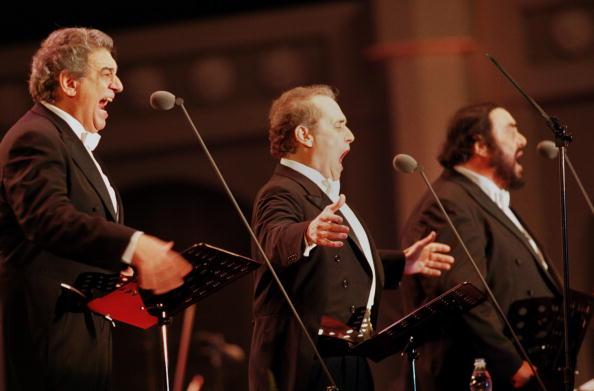They drew huge crowds, sometimes large enough to fill stadiums. They had the best conductors and orchestras to support their immense talent. Each one was a star in his own right, but together the Three Tenors changed the commonly held perceptions about classical music and introduced millions to the delights of opera.
José Carreras, Plácido Domingo, and Luciano Pavarotti were the biggest names in the operatic world and were constantly in demand.
At a time when the operatic world was extremely competitive and exclusive, the format of three male tenors performing together had, understandably, never been done before. Carreras had just returned to the stage after a bout with cancer; all three were avid soccer fans.
As a fundraiser for Carreras’s leukemia foundation, and on the eve of the World Cup, they performed for the first time on July 7, 1990 in an open-air setting at the ancient Baths of Caracalla in Rome. This performance, with Zubin Mehta conducting the Orchestra del Maggio Musicale Fiorentino and the Orchestra del Teatro dell'Opera di Roma, created a sensation, one for the classical music record books.

The performance broke all attendance records. The concert was aired live on television, which was unusual for classical concerts at the time. With a live audience of 6,000, the performance was watched by a television audience of over 1 billion. The recording became the best-selling classical album of all time.
The Three Tenors Phenomena
While most classical singers performed in smaller concert halls, the Three Tenors filled huge venues, using microphones to amplify their sound, and large screens for those in the back seats. They first performed in a stadium during their 1994 Los Angeles performance.That year, Dodger Stadium was transformed into a huge concert hall, and the performance was a sellout. The tenors were accompanied by the Los Angeles Philharmonic and the Los Angeles Music Centre Opera Chorus, conducted by Zubin Mehta. A crowd of 56,000 filled the stadium. The live concert was broadcast on television in over 100 countries. This memorable performance, with over 1 billion TV viewers, had created fans who followed the Three Tenors from then on.

Their concerts attracted people from all walks of life, from the general public to opera lovers to politicians and celebrities, including former presidents and actors such as Tom Cruise, David Hasselhoff, and Arnold Schwarzenegger. Gene Kelly and Frank Sinatra also attended a performance, wearing broad smiles as the tenors performed “Singin’ in the Rain” and “My Way,” among selections of opera arias and Neapolitan folk songs.
Enduring Legacy
The Three Tenors performed at every World Cup until 2002; between 1994 and 2003, they performed 30 concerts at large venues all around the world, until Pavarotti’s retirement in 2004. In the late 1990s and early 2000s, the trio’s recordings were constantly at the top of classical sales charts, and their concerts were always sold out. Not only was this phenomenon a huge commercial success, but it also contributed to a significant growth in opera audiences.Audiences became familiar with some of the most imposing pieces of the operatic repertoire, such as the works of Puccini and Verdi. Through the Three Tenors’s concerts, audiences were encouraged to listen and enjoy more opera on their own, attending traditional concerts and productions in opera houses. The Three Tenors made opera enjoyable and fun to a modern, hip generation; opera was no longer serious and exclusive. Whether people came to like opera or not, the general public recognized the huge talent and exceptional charisma of the three singers.
The Three Tenors legacy is still very much alive today, and the franchise is still frequently featured in the media. Singers in the classical work frequently become part of groups modeled on the Three Tenors format: big amplified vocal sounds and large viewing screens on stage, full orchestras, major venues, and a popular repertoire featuring new arrangements. It opened a door to a previously narrow classical market and paved the way for crossover artists.

The Three Tenors ushered in a new era in crossover music by putting on a concert in a nonclassical setting, known as “popera.” The classically trained singers achieved something that nobody dared before, inspiring a new generation of artists, like Andrea Bocelli, Il Vovo, and Forte, as well as other tenor trios such as the Irish Tenors, Texas Tenors, and the Three Mo’ Tenors, making classical music accessible to anyone.
The Three Tenors’s were great singers and great friends, and they succeeded in sharing great music with the world.






